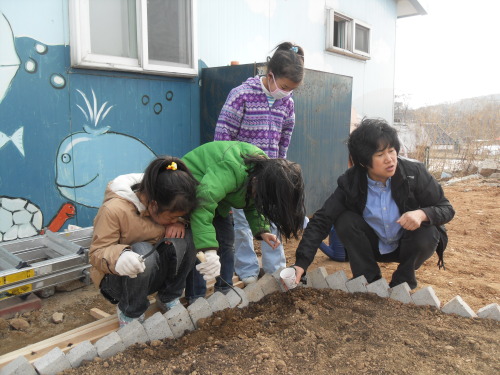Nationwide refurb program makes Korean afterschool centers sparkle againUntil this month, kids at Jun Jin-kyoung’s Ganghwado children’s center were always fighting over the bathroom.
“There was no separate restroom for males and females. It could sometimes make conflict for the children as they grew up. They wanted the restroom separated,” said Jun, who is president of the care facility on the island off the coast of Incheon.
Separate bathrooms might seem trivial, but for the 27 kids attending Heemangteo Local Children’s Center, many of whom lack stability in their personal lives, the afterschool care facility is like a second home.
“Most of the children have been coming for an average of four or five years. It means they spend more time with us in the center than they do with their parents,” explained Jun, who now runs the center with four other staff after starting it to care for a friend’s children eight years ago.

Children and Heemangteo president Jun Jin-kyoung tend the center’s garden. (Heemangteo)
“Now they come to the center right after school feeling like it is their home.”
And Heemangteo’s home from home just got better for its elementary and middle school student attendees. It has new separate girls’ and boys’ bathrooms as well as a refurbished kitchen, after benefiting from a large-scale project that is revamping 154 centers across Korea.
The project organized by YMCA and YWCA Korea and sponsored to the tune of 2 billion won by Samsung Life Insurance social contribution committee is remodeling 314 restrooms and kitchens at facilities across six Korean cities.
Yoon Sang, deputy head of department at Samsung Life Insurance Social Contribution Committee said: “We recognized that facilities in the local kids’ centers where kids from lower income families spend their time are poor, and we wanted to increase the quality of children’s welfare.
“We couldn’t support all of the things practically, but we wanted them to live in pleasant and sanitary places at least. So we started to donate funds to repair old kitchens and restrooms.”
And such repairs were badly needed.
There are now almost 3,700 Local Children’s Centers in Korea, providing academic, art and drama programs as well as free meals for kids from low income families, but many have received little repair work since being established around 1997.
At that time, more working parents were forced to leave kids home alone during and following the economic crisis. Centers first cropped up in poor urban areas such as Seoul’s Sillim-dong or Bongcheon-dong, and later in fishing and farm villages.
“Increasingly, kids and adolescents were left alone at that time, the new issue of caring for them arose,” explained a spokeswoman for the YWCA and YMCA.
“From the beginning, individuals built the centers to care for the kids left alone for free, so the facilities are very poor.”
The government has been giving around 3.4 million won a month to each center since 2004, but the spokeswoman said there was no budget for renovations.
“They spend the money feeding kids, paying teachers and operating the centers. The facilities are still as when they were first established. That’s why the restrooms are old and smelling and the kitchens have bad ventilation.”
Although other organizations have donated equipment and cash, she said this renovation project was the first of its kind.
Heemangteo’s renovations were completed on May 27, but the project is continuing throughout June at centers in Incheon, Daejeon, Daegu, Busan, Ulsan and Gwangju.
Jun explained why a stable environment that is also clean and appealing was so important for kids.
“These children should be innocent but they have the heavy burden of physical and mental problems such as victim mentality, depression, abnormal behavior, violent language or physical aggression,” she said.
“I think each local person has a role and obligation to raise kids together, they are the future of our nation. To accomplish that local children’s centers have to help kids adapt to their surroundings.”
She said that without the center, kids would be left playing alone or fighting each other for seats at PC bangs.
“I look back at my childhood and I feel sorry for current surroundings: no one has time to spare for others. Parents cannot help it that they have to earn money for a living, and have to leave kids alone.
“But some parents do not let their kids go to the center even though they don’t care for them. Those children come in and out of PC bangs as if they are their homes.”
The center is supported by the adjoining Anglican church established in 1906. The congregation donates 300,000 won a month and leases the center facilities for free. Other locals donate a total of 400,000 won each month, while the government provides just under 3 million won.
“We got donations from several organizations and individuals for the kitchen, but we still had problems cooking properly for the children,” said Jun.
“Now that we have a new kitchen, the kids are happy serving themselves meals.
“Now the kids don’t suffer when they need to go to the restroom, and they even clean the new restroom themselves.
“It became pleasant and nice. We couldn’t imagine that that would happen, now we truly believe that dreams can come true.”
By Kirsty Taylor (
kirstyt@heraldcorp.com)






![[Graphic News] More Koreans say they plan long-distance trips this year](http://res.heraldm.com/phpwas/restmb_idxmake.php?idx=645&simg=/content/image/2024/04/17/20240417050828_0.gif&u=)